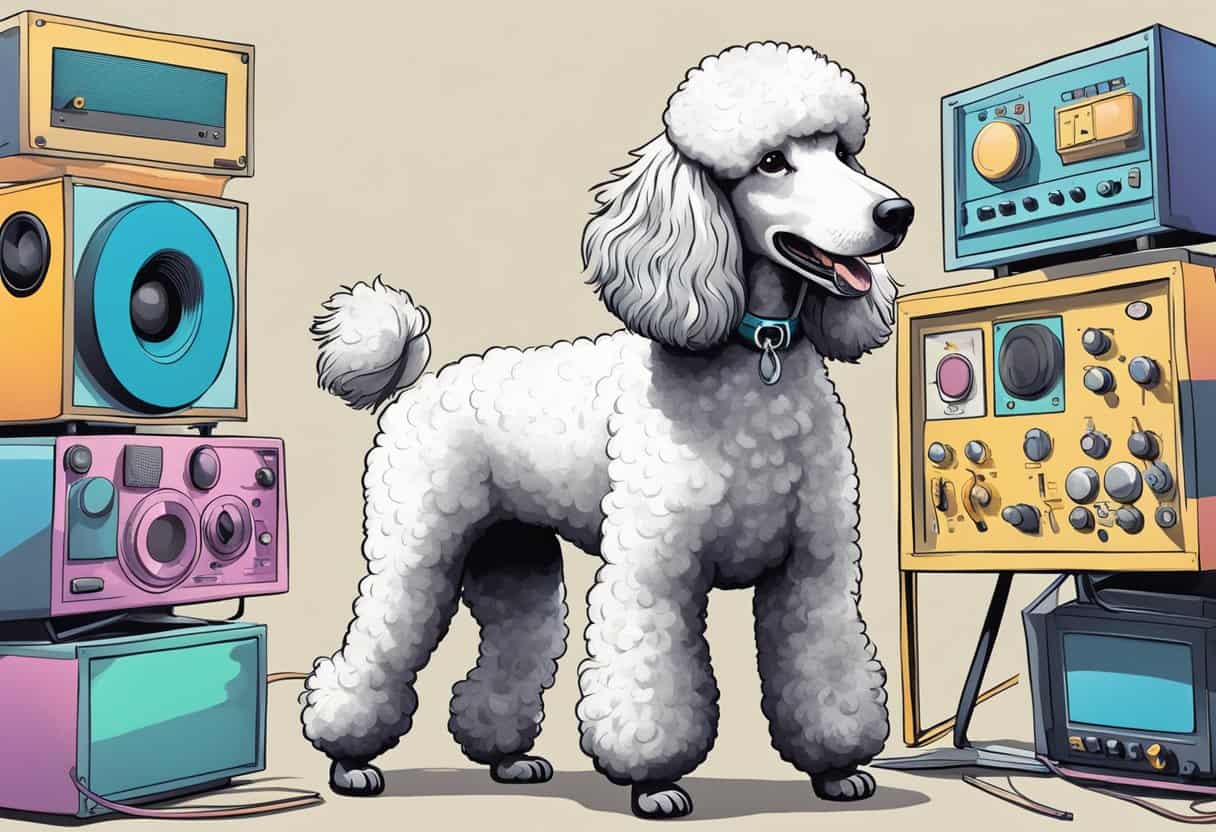This post may contain ads and affiliate links and we may earn a small commission when you click on the links at no additional cost to you. As an Amazon Affiliate, we earn from qualifying purchases. You can read our full disclaimer here.
Do Poodles Howl? Decode the Secret Language of Your Poodle

Do poodles howl? You bet they do (or can)!
Those stylish, fluffy poodles, often seen prancing around with an air of elegance, are not just about good looks and brains.
Despite their posh appearance, they’re full of surprises. Imagine a poodle, poised and polished, suddenly breaking into a howl.
It’s like finding out your most dignified friend is secretly a karaoke superstar.
Their owners often do a double-take, wondering if their sophisticated fur baby just channeled their inner wolf!

Do Poodles Howl? Are they even capable of it?
Just like any other dog, poodles are fully capable of howling, although it’s not their go-to form of communication.
They might howl for various reasons, such as responding to high-pitched noises, expressing emotion, or signaling distress. It’s your poodle’s way of reaching out over distances to communicate with you or their canine companions.
Understanding why and when a poodle decides to howl can give you insight into their mood and needs.
Whether they’re feeling sociable or they’ve heard something that’s triggered their response, the sight of your poodle tilting their head back and serenading can be quite a spectacle.
So if you hear your poodle howl, take a moment to appreciate this deep-rooted canine behavior.
Understanding Poodle Behavior
When it comes to poodles, their behavior is both complex and fascinating. You’ll find they have unique ways of communicating.
Howls Versus Barks
Poodles may bark or howl for various reasons. Barking is a poodle’s sharp, short form of vocalization, often used to alert you of something specific like an unfamiliar person at the door.
On the other hand, howling is a more prolonged, mournful sound. It can be a throwback to their wolf ancestors, possibly a response to high-pitched sounds or a form of long-distance communication.
- Bark: Alerting to immediate issues.
- Howl: Responding to high-pitched noises or for communicating over distances.
Poodle Communication Methods: More Than Just Bark and Bite
Poodles are not just adorable; they’re skilled communicators. Their repertoire includes a range of sounds and body movements, each conveying different emotions or desires.
Understanding these signals can deepen your connection with your poodle.
Vocalizing: Expressing Emotions or Seeking Attention
Poodles are quite the vocalists. Beyond the typical barking, they might howl, whine, or engage in a kind of melodious ‘singing.’
Poodles use a range of vocalizations to communicate different emotions or needs. Here are some common vocal cues and their possible meanings:
- Barking: A standard form of communication. Rapid barking often indicates excitement or alertness, while a lower, more prolonged bark might signal a warning or a threat.
- Howling: This can be a sign of loneliness or a response to certain stimuli like sirens. It may also be a way for your poodle to join in on ‘group vocalizations’ with other dogs.
- Whining or Whimpering: Typically, this indicates a need or desire, such as wanting food or attention. It can also be a sign of discomfort or stress.
- ‘Singing’ or Musical Barking: This unique vocalization is often a sign of happiness and excitement. It’s like your poodle’s way of expressing joy in a melodious manner.
These sounds are ways for your poodle to express feelings like excitement, the need for attention, or even discomfort.
By tuning into these vocal cues, you can gain insights into your poodle’s emotional well-being.
Body Language: Indicating Feelings or Intentions
Poodles also use their body language to communicate. Here are some key body language signals and what they might mean:
- Tail Wagging: Generally indicates happiness or excitement. A fast, vigorous wag can mean extreme joy, while a slow wag might suggest a more relaxed or inquisitive state.
- Ear Positioning: Ears perked up can signal alertness or interest, while ears pinned back might indicate fear or aggression.
- Body Posture: A relaxed posture with a level back shows contentment, whereas a lowered body might mean submission or fear.
- Eye Contact: Direct eye contact can signify confidence or a desire for interaction, whereas avoiding eye contact could indicate nervousness or submission.
By observing these body language signals, you can better understand your poodle’s feelings and intentions, leading to a more harmonious relationship.
Signs of Separation Anxiety in Poodles
Separation anxiety in poodles manifests as excessive barking or howling, especially when left alone. You might notice signs of distress like whining, chewing objects, or pacing.
These anxious behaviors often stem from loneliness and a strong desire for your companionship.
If your poodle is exhibiting signs of anxiety, it could be a signal that they require more mental stimulation, a change in their environment, or possibly the help of a professional dog trainer. Anxiety in poodles can manifest in various behaviors and emotional signs.
Anxious Behaviors
- Excessive Barking: Continuous or unprovoked barking can be a sign of anxiety or stress in your poodle.
- Destructive Chewing: Chewing on furniture, shoes, or other inappropriate items can indicate anxiety or boredom.
- Restlessness: If your poodle seems unable to settle down, pacing or moving around constantly, it might be experiencing anxiety.
- Excessive Licking or Grooming: Over-grooming or licking themselves more than usual can be a sign of stress in poodles.
- Avoidance or Hiding: Avoiding interaction or hiding in unusual places can indicate fear or anxiety.
- Shaking or Trembling: Unexplained shaking or trembling could be a response to stress or nervousness.
Emotional Signs
- Whining or Pacing: These behaviors can suggest distress, sadness, or discomfort in your poodle.
- Change in Appetite: A sudden decrease in appetite can be a sign of stress or anxiety.
- Lack of Interest in Activities: Losing interest in play or walks, which were previously enjoyed, can indicate emotional distress.
- Changes in Sleep Patterns: Experiencing more frequent sleep disturbances or sleeping more or less than usual can be signs of anxiety.
- Yawning or Drooling: Excessive yawning or drooling, not related to food or physical exertion, can be stress indicators.
Recognizing these signs of anxiety and emotional distress is crucial in providing the right support for your poodle. Whether it’s through increased mental stimulation, changes in routine, or seeking professional advice, addressing these signs early can help ensure the well-being of your pet.
Do Poodles Howl? Want to Know How to Teach Your Poodle to Howl
Teaching your poodle to howl can be a fun and rewarding experience. By using specific commands, positive reinforcement, and managing unwanted howling, you can train your poodle in an effective way.
Using Commands to Encourage Howling
First, find a trigger that naturally makes your poodle want to howl, such as a siren or a musical instrument. Once you’ve found this trigger, you can start associating it with a verbal command like “Sing” or “Howl.”
Make sure to use a clear and consistent tone when giving the command. Say your chosen word right before the trigger happens, so your poodle can connect the command with the action of howling.
Reward-Based Training Techniques
As your poodle begins to howl on command, immediately offer praise and a treat as a reward.
Keep a stash of treats to keep the training session flowing smoothly. Here’s a simple breakdown:
- Give Command: “Howl” or “Sing”
- Poodle Howls: Immediately after the howl
- You Reward: With treats and praising words like “Good howl!”
Consistent reward-based training, or positive reinforcement, helps enforce the behavior you want.
Dealing With Unwanted Howling
Sometimes, a poodle may howl excessively or at inappropriate times. If this happens, avoid giving attention or treats which could inadvertently reinforce the behavior.
Instead, redirect your poodle’s attention to a different, quiet behavior and reward that. Use commands like “Quiet” or “No howl” followed by a treat when they obey. This teaches them that not howling can also lead to rewards.
Starting with these techniques, you’ll be able to train your poodle to howl on command and manage their howling habits effectively.
Poodle Responses to External Stimuli

Your poodle’s behavior can change in response to different sounds and environmental factors. These responses can provide insights into their emotional state and natural instincts.
Do Poodles Howl when Reacting to Sirens and Musical Instruments?
Sirens: When your poodle hears a siren, they might respond by howling. This behavior is similar to the communication methods seen in their wild ancestors, who howled to alert their pack. It’s a call-and-response scenario; your poodle might interpret the siren as a distant call from another ‘dog’.
Musical Instruments: Particularly singing and playing the harmonica can trigger your poodle’s howling. It’s believed the musical notes either mimic or clash with natural dog vocal ranges, causing your poodle to join in or possibly even ‘correct’ the sounds.
Environmental Factors That Influence Howling
You’ll see that your poodle’s surroundings play a huge role in their inclination to howl. Factors like:
- Confined Spaces: More echoing can make a poodle more likely to howl.
- Group Settings: Builds a sense of community and excitement, which can trigger howling.
- Ambient Noise Levels: Can either overwhelm your poodle or encourage them to vocalize.
These environmental stimuli often tap into your poodle’s instinctive behaviors.
Excitement, in particular, is a strong driver for vocal reactions like howling as your poodle engages with their surroundings and communicates their emotions.
The Social Aspect of Poodle Howling

When your poodle howls, they’re not just being vocal; they’re communicating and reinforcing social bonds within their pack.
Understanding this behavior connects you to the deep-rooted social instincts that poodles share with their wolf ancestors.
Bonding With the Pack Through Vocalizations
Your poodle uses howls to bond with you and other pets. These vocalizations serve as a social glue, strengthening the sense of belonging within the pack.
When you hear your poodle howling along with you or other dogs, they’re expressing their place and bond within the group. It’s their way of reaching out and saying, “I’m with you.”
Do Poodles Howl and Mimick Wolves and Other Dogs
Poodles might seem a world away from their wolf cousins, but they still carry that wild love for conversation within their genes.
When your poodle tilts their head back and howls, it’s like they’re throwing back to their wolf heritage.
Poodles, much like wolves, huskies, and other vocal hound breeds, use their howls to communicate across distances and mimic the sounds of their pack. This behavior is a nod to their shared lineage with wolf-like dogs.
Health and Howling: When to Be Concerned

When your poodle howls, it can be a sign of underlying health issues or emotional distress. It’s important to know when this behavior warrants concern.
Pain-Induced Howling
If your poodle suddenly starts howling or does so when moving, it might be expressing pain. Watch for signs like limping, reluctance to play, or changes in appetite.
These could be warning signs of health problems.
Body language to observe:
- Hunched back
- Ears pinned back
- Tail tucked
Do Poodles Howl? Identifying Emotional Distress
Howling can also be a plea for mental stimulation, especially if your poodle is left alone frequently.
If the howl sounds mournful and is accompanied by pacing or destructive behavior, it’s probably a sign your buddy needs more interaction or activities.
Tips to mitigate howling from emotional distress:
- Provide Regular Exercise: Ensure your poodle gets plenty of physical activity. Regular walks, playtime, and exercise can help expend excess energy and reduce anxiety.
- Mental Stimulation: Engage your poodle’s mind with puzzle toys, training sessions, and games. Mental stimulation can prevent boredom and reduce stress-induced behaviors.
- Establish a Routine: Consistency in daily activities like feeding, walks, and bedtime can provide a sense of security and reduce anxiety.
- Create a Safe Space: Designate a comfortable area in your home where your poodle can retreat to when feeling overwhelmed or anxious.
- Positive Reinforcement: Use treats and praises to encourage calm behavior. Avoid scolding or punishment, which can increase anxiety.
- Desensitization Training: Gradually expose your poodle to the stimuli that trigger howling, using positive reinforcement to build positive associations.
- Companionship: Sometimes, the presence of another pet or more frequent human interaction can alleviate feelings of loneliness and anxiety.
- Calming Products: Consider using calming products like pheromone diffusers, anxiety wraps, or soothing music designed for dogs.
- Regular Vet Checkups: Ensure your poodle is in good health. Sometimes, underlying health issues can contribute to anxiety and stress.
- Professional Help: If howling persists or is severe, consult a professional dog trainer or a veterinarian specializing in behavior for personalized advice and treatment.
Distinctive Poodle Traits
In exploring poodle traits, you’ll discover their unique vocal behaviors and how size impacts their characteristics.
The Uniqueness of Poodle Vocalizations
You might find that poodles have a distinct voice. They can howl, bark, and produce a range of sounds that reflect their expressive personality.
Their vocal cords allow for a variety of vocalizations, different in pitch and intensity depending on the situation.
- Howling: Rare in poodles but possible, especially when they engage with certain stimuli or communicate distress.
- Barking: Poodles bark to alert you, show excitement, or signal that they want attention.
Characteristics of Different Poodle Sizes
Poodles come in three main sizes: Standard, Miniature, and Toy. Each one has characteristics shaped by their size.
- Standard Poodle: This is the largest type, strong and active, with a deeper bark that commands attention.
- Miniature Poodle: Smaller than the standard, but still hearty, often with a bark that’s high-pitched yet forceful.
- Toy Poodle: The smallest with a petite frame, their bark is often sharp, reflecting their spirited personality.
Table 1: Poodle Size and Vocal Characteristics
| Poodle Size | Bark Characteristic | Vocal Energy |
|---|---|---|
| Standard | Deep and resonant “woof” | High and authoritative |
| Miniature | High-pitched yet forceful bark | Energetic with a sense of urgency |
| Toy | Sharp and high “yap” | Spirited and attention-grabbing |
Each size of poodle carries its own distinct voice which is part of what makes them so unique.
Adapting to Your Poodle’s Vocal Needs

Your poodle’s howling might be their way of expressing fear, alerting you to danger, or simply a call for attention. Recognizing the why and how to manage their vocal behavior can help create a harmonious living situation.
Creating a Comfortable Environment
Provide your poodle with a safe space like a kennel where they can retreat to when they’re feeling scared or overwhelmed.
This can dramatically reduce anxiety-induced howling. Ensure the environment is quiet to prevent unnecessary stress.
To that end, using a grooming routine can be soothing and establish a calming environment. Perhaps consider investing in a camera to keep an eye on your poodle when you’re at a distance, which can help you understand their needs better when they start to howl.
Managing and Redirecting Howling
If your poodle starts howling, address their behavior promptly. Use a verbal cue to interrupt the howling and encourage quiet with rewards when they comply.
Regular exercise at a dog park can help burn off the energy that might otherwise be channeled into howling.
Engaging in play or a training session can redirect their attention and reduce the frequency of howling.
Poodle Mixes and Howling Patterns

When exploring poodle mixes and their propensities for howling, it’s key to understand that breed-specific vocal traits and the sounds unique to hybrid poodles can vary.
Breed-Specific Vocal Tendencies
Typically, poodle mixes inherit a blend of traits from both parents. This mix also influences their vocal behaviors.
Consider the Bassetdoodle, a mix of a poodle and a Basset Hound—a breed known for its distinct howl. Your Bassetdoodle might inherit a proclivity for that mournful howl, especially when feeling sad or seeking attention.
In general, poodle mixes that involve other hunting dogs, such as the Eskapoo (an American Eskimo and Poodle mix), may exhibit more vocal tendencies than a standard poodle.
The genetics at play influence these patterns and can result in a less predictable range of sounds.
Hybrid Poodles and Their Unique Sounds
The Doxiepoo, a Dachshund-Poodle mix, might offer an interesting mix of sounds. Dachshunds were bred to hunt, often needing to bark and howl, and this trait could pass down to your Doxiepoo.
You’ll notice the blend of its parent’s sound can vary, from sharp barks to the characteristic poodle bark, and possibly a howl if the conditions are right or the dog is attempting to communicate a specific need.
Do Poodles Howl? Final Answer
In conclusion, yes, poodles do howl, along with displaying a wide array of other vocalizations and body language cues.
Understanding these signals is key to strengthening your bond with your poodle, ensuring a harmonious and joyful relationship.
By recognizing and responding to their unique ways of communication, you can cater to their emotional and physical needs more effectively.
-

Coffee Mug – In Dog Coffees I’ve Only Had One
$11.95 – $14.95 Select options This product has multiple variants. The options may be chosen on the product page
